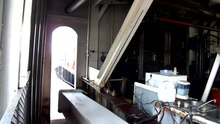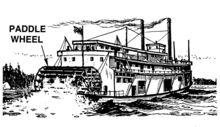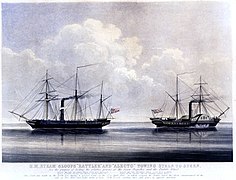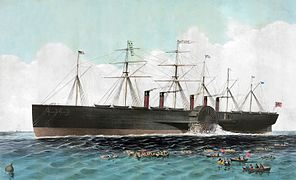Paddle steamer

A paddle steamer is a steamship that is driven by two side paddle wheels ( side wheel steamer ) or one wheel located at the stern ( stern wheel steamer ). Paddle steamer for towing barges are Raddampfschlepper called.
Paddle steamers were mainly built in the late 19th and early 20th centuries, when steam shipping was the state of the art in shipbuilding . The slow-running steam engines were very suitable for driving the paddle wheels, which were up to several meters in diameter .
Some paddle steamers have been preserved and are still used today, mainly for tourist purposes. They consume around two to three times as much fuel as comparable diesel motor ships, which results in higher operating costs and greenhouse gas emissions. This is why the paddle steamers are mainly used on the Swiss lakes as public attractions on the main tourist routes.
Paddle wheel
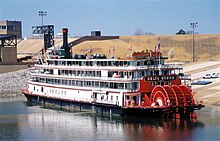
A paddle wheel for ship propulsion has an axle shaft to which plates or “ shovels ” are attached radially with additional holding devices (classic shape). Mounted on the side or at the stern, the continuous rotation of the immersing blades creates a propulsion .
In the case of paddle wheels with rigidly attached, radially aligned paddle plates, the immersing shovel hits the water more or less obliquely, depending on the position of the axis above the water surface, and the protruding shovel has the same position in the opposite direction. As a result, a considerable part of the drive energy is used, in addition to propulsion, only to push water both downwards and upwards.
For this reason, eccentric-controlled wheel blades (feathering wheel) were used practically from the start , which dip almost vertically into the water and are guided through the water in this position. This control of the paddle wheels , which works according to a very simple principle and which significantly increases the efficiency of the paddle wheels, does not represent a later improvement of the paddle wheel drive, but belongs in the context of the development of mechanical ship drives, i.e. the paddle wheel and the propeller, in the first Third of the 19th century.
In most side wheel steamers, both paddle wheels are attached to a continuous shaft and are driven synchronously by a common machine system. However, if increased maneuverability up to and including turning on the spot is required, typically with side-wheel harbor tugs , or if a transversely continuous wheel shaft would conflict, for example with the longitudinally continuous vehicle deck of a side-wheel, car or, in particular, rail ferry (for reasons of stability ) , each paddle wheel is often driven by its own, independently controllable machine.
history
The use of paddle wheels in shipping is documented for the first time by the Roman engineer Vitruvius , who in his work “De architectura” (X 9.5-7) describes a paddle wheel that functions as a ship's odometer. The anonymous Roman war pamphlet " De Rebus Bellicis " from the late 4th century contains the proposal for a warship with several paddle wheels, driven by oxen (Chapter XVII). This idea was demonstrably implemented for the first time in China, when Admiral Wang Zhen'e equipped his fleet with paddle wheels to fight pirates on the Yangtze River in 418 (see Chinese paddle wheel boats ).
The Pyroscaphe was the world's first working paddle steamer and was designed by Claude François Jouffroy d'Abbans in 1782. The second working paddle steamer is the Charlotte Dundas, built in 1801 . Her paddle wheel was still inside the fuselage at the stern. In 1807 the American Robert Fulton built the first economically successful paddle steamer. His wooden Clermont ( North River Steam Boat ) with a steam engine from James Watt was the first steamship that could be operated profitably.
So-called smooth - deck or single-deck steamers had no superstructures other than the wheel arches . From the 1870s onwards, saloon steamers were used to transport passengers in inland shipping , which are characterized by superstructures that span a large part of the length of the ship. At the same time, for example, several smooth- deckers were converted into so - called half- saloon steamers on Lake Lucerne , with a saloon for the first class being built on the aft deck .
The paddle steamer Montreux , which is sailing on Lake Geneva , was dismantled from diesel to steam operation in 2000 after 40 years ; its drive is considered to be the first electronically controlled steam engine. The operating costs should be in the order of magnitude of a modern diesel drive, but cause a significantly lower environmental impact.
distribution
United States
The film made the "typical American paddle steamer" famous on the Mississippi River , although it was also widespread on many other rivers. Its flat hull and the large paddle wheel at the stern made it possible to navigate shallow waters with many sandbanks. The height of its importance for passenger transport was around the middle of the 19th century. The expansion of the railroad network and the outbreak of the US Civil War ensured that other modes of transport came to the fore. In historical times, many side-wheel steamers were on the Mississippi. For example, the largest cargo steamer in the American West, the Hill City , was a side wheel steamer that, after being rebuilt and renamed the Corwin H. Spencer, operated as an excursion steamer at the 1904 World Exhibition in St. Louis.
In contrast to European paddle steamers, the ships built and operated in the USA regularly used standing steam engines with a considerable overall height (balancing machine).
Some paddle steamers, such as the Mississippi Queen , were completely rebuilt in the 1970s using historic steam engines.
Europe

In Europe, paddle steamers with two paddle wheels at the side, about amidships, prevailed. Since the 1970s, many paddle steamers in Europe have been saved from scrapping and extensively restored. Therefore, paddle steamers that are still used by tourists today operate on some of the major rivers and lakes in Europe.
Germany

In Dresden , Sächsische Dampfschiffahrt operates nine historic paddle steamers, according to its own information, the largest and oldest paddle steamers fleet in the world, including the diesbar from 1884. It is powered by the world's oldest steam engine from 1841 that is still in use under monument protection and is still fired with coal. The other eight paddle steamers still have their old steam engines, but these have been converted to run on oil. They are in use every day in summer. The youngest and largest steamer, the Leipzig , dates from 1929.
Also on the Elbe near Lauenburg is the coal-fired steamer Kaiser Wilhelm , kept in motion by an association. The last side paddle steamer, the Goethe of the Cologne-Düsseldorfer , drove on the Rhine on the route from Koblenz to Rüdesheim am Rhein . It has now been converted into a diesel-powered wheel motor ship. The Weserstolz is the only paddle steamer operated on the Weser . Another former paddle steamer, the Diessen , which has been converted to a diesel engine drive , operates on the Ammersee in Bavaria , as does the Ludwig Fessler (built in 1926) on the Chiemsee. The Herrsching (built in 2002), which also operates on the Ammersee, also looks like a paddle steamer, but was a diesel-powered paddle ship from the start.
The motor ship Elbe Princesse (built in 2016) sails on the Elbe and Havel and is powered by a combination drive consisting of two rear paddle wheels and two jet drives. The special feature of the new building was the use of rigid paddle wheels. Because of their inefficiency and strong vibrations, they were replaced by eccentric paddle wheels in 2017.
Switzerland
In 2015, a total of fifteen paddle steamers operated on schedule in Switzerland .
Five paddle steamers built between 1901 and 1928 are in use on Lake Lucerne for the shipping company of Lake Lucerne : Uri , Unterwalden , Schiller , Gallia and the city of Lucerne . The Compagnie Générale de Navigation sur le Lac Léman (CGN) on Lake Geneva is the owner of eight historic paddle boats built between 1904 and 1927. Five of them operate as paddle steamers. The Montreux received after an earlier conversion to diesel-electric drive in 2001 again a steam engine. After modifications, three are currently diesel-electric powered wheelboats: Helvétie , Italie and Vevey . The Helvétie is currently out of service and awaiting renovation. A ninth ship, the Genève , has been out of service since 1973 and is used by a non-profit association in Geneva. The Lake Zurich shipping company operates on the Lake Zurich , the city of Rapperswil and the city of Zurich from the contract sections 1909 and 1914. The BLS AG is on the Brienz owner of the Lötschberg (built in 1914) and on the Lake of Thun operator of the Blümlisalp from the former shipyard of Escher Wyss AG in Zurich . The Neuchâtel , built in 1912, operates on the Jura lakes and has been in use again since 2014 after extensive restoration and the installation of a used steam engine.
In Eastern Switzerland, an association is campaigning for the construction of a new paddle steamer that will operate on the Upper Rhine and Lower Lake between Schaffhausen and Kreuzlingen . Firing with wood pellets is planned .
Austria

There are still three active paddle steamers in Austria .
Gisela from 1872, named after a daughter of Emperor Franz Josef , runs on the Traunsee . A special technical feature is her oscillating compound steam engine from Prager Maschinenbau AG.
The paddle steamer Schönbrunn from 1912 is a reminder of the great times of the First Danube Steamship Company (DDSG) . It is located in Linz and was made ready to run again by the Austrian Society for Railway History (ÖGEG) and is used for special trips.
The Hohentwiel , a former state yacht of the King of Württemberg, is actually a German ship, sailing under the Austrian flag on Lake Constance .
The famous steamer Emperor Franz Joseph I , also featured in the operetta Im Weißen Rößl , no longer runs on the Wolfgangsee in the Salzkammergut , although it has largely been restored to its state of 1908. It has had a diesel engine drive since the 1950s.
The city of Vienna in Tulln is also not a real paddle steamer. This wheel motor ship , built in 1939 in the Korneuburg shipyard , has a (still original) diesel-electric drive with Sulzer diesel engines and electrical equipment from Brown Boveri , which at the time was based on Swiss models.
Italy
In Italy there are still 3 paddle steamers powered by a compound steam engine. On Lake Maggiore the Piemonte (built in 1904) and on Lake Como the Concordia (built in 1926) and the Patria (built in 1927). The Piemonte is usually only used for special trips, the Concordia and Patria also operate on scheduled routes in summer (as of 2017).
In addition, two side wheel ships that have been converted to diesel-electric propulsion operate on Lake Garda : the G. Zanardelli (built in 1903, converted in 1982) and the Italia (built in 1908, converted in 1977).
A former paddle steamer is still in operation, from which the paddle wheels have been removed and which has been converted into a motor ship: the Milano (built in 1904, converted to MTU Diesel in 1926) on Lake Como .
Another two paddle steamers are still available as a bar or restaurant. The Lombardia (built in 1909) in Arona and the Bisbino (built in 1907) in Tremezzo .
Great Britain
The Waverley , the last still active paddle steamer , operates between Helensburgh and Kiscreggan or Gourock in Scotland .
Norway
The oldest paddle steamer in the world still in operation, the Skibladner , operates on Lake Mjøsa in Norway . It has been connecting the towns on the banks of the river, including Lillehammer, Moelv, Gjøvik, Hamar and Eidsvoll, since 1856, and has also served as a mail boat. Today, the ship is primarily a tourist attraction and runs on scheduled services in summer.
Denmark
In Denmark , the Hjejlen, built in 1861, operates in the Silkeborg Lake District .
Asia
North Korea
In 1984 the North Korean dictator Kim Il-sung visited Dresden and Saxon Switzerland during his state visit to the GDR . He liked the trip with the paddle steamer Dresden so much that he had a replica of the ship anchored in Pyongyang made based on original drawings from the Laubegast shipyard in North Korea .
Paddle steamer in military use
Paddle steamers were also used as warships. However, they were not considered full-fledged combat ships, but were used as auxiliary and special ships. Their advantages were, on the one hand, their independence from the wind as the drive source, and, on the other hand, their hitherto unattained agility and maneuverability; with paddle wheels working in opposite directions, they could turn practically on the spot and achieved approximately the same speed both forwards and backwards. That moved u. a. the British government during the Crimean War 1853-1856 to exchange two Radavisos previously sold to Prussia (SMS Nix and SMS Salamander ) in 1855 for the sailing frigate Thetis . Disadvantages were the still inadequate operational safety of the drives and the susceptibility of the large paddle wheels to artillery fire. As a compensation or occasional drive, wheeled warships kept their sails, mostly they were rigged as square or gaff schooners, sometimes also as barque. The available steam engines, with their voluminous engine rooms and coal bunkers, also displaced the previous main armament from their usual broadside installation. However, this contributed to the progress of ship artillery, because the guns set up in turrets on the upper decks had a larger field of fire.
There were three types of steam paddle warships:
- Radavisos had a displacement of 400 to 1150 t and carried two to four small-caliber guns on the upper deck. They were used for reconnaissance and courier services. A representative of this ship class is the Prussian SMS Loreley , which took part in the naval battle near Jasmund (1864) .
- Radkorvetten displaced 750 to 1,600 t and carried six to twelve large-caliber bomb cannons, e.g. Some of them can already be rotated on the fore and aft deck. Their field of activity was reconnaissance and security. In Germany, only one representative of this class of ship was launched, the corvette Danzig .
- Wheel frigates displaced 1,200 to 3,000 tons and carried 14 to 20 medium-caliber guns in a broad-side position and possibly also over some large-caliber bomb cannons on the upper deck. One of the German representatives of this class was the Barbarossa , the flagship of the war fleet of the Frankfurt National Assembly.
With the advent of the screw drive, the question of more efficient drive arose. For this purpose, the Royal Navy organized a comparison in 1845 between the paddle steamer Alecto and the screw steamer Rattler , both of which were equipped with engines of the same power. The Rattler already won the simple comparison of speeds . In the second attempt, both ships were connected with a chain stern to stern and drove with full power on the opposite course. The screw steamer succeeded in pulling the paddle steamer noticeably and measurably with the maximum power of both machines.
gallery
Meissen on the Upper Elbe
The Great Eastern , Isambard Kingdom Brunel , 1858
Susquehanna , one of the four "Black Ships" by Matthew Calbraith Perry , 1933/34
See also
- Steamship
- Steamboat
- Danube Shipping Museum Regensburg
- Steam boat trip on Lake Constance
- List of active steamers
- Rhine steamer
literature
- Karl Radunz: 100 years of steam shipping 1807-1907 . 1st edition. European University Press, 2011, ISBN 978-3-86741-668-9 . ( Online preview on Google Books )
- Alfred Dudszus, Alfred Köpcke: The big book of ship types . Weltbild Verlag (licensed edition by transpress, Berlin), Augsburg 1995, ISBN 3-89350-831-7 .
- Jürgen Gebauer, Egon Krenz: Maritime Dictionary . Military publishing house of the GDR, Berlin 1989, ISBN 3-327-00679-2 .
- Dieter Flohr, Robert Rosentreter: German Marine Calendar 1991 . Brandenburgisches Verlagshaus, Berlin 1990, ISBN 3-327-00913-9 .
- Helmut Hanke: Men, planks, oceans . 8th edition. Urania-Verlag, Leipzig / Berlin / Jena, 1982, ISBN 3-332-00238-4 .
Web links
Individual evidence
- ^ Paul Schneeberger: Swiss Steam Ships: Greater effort, priceless added value . In: NZZ , July 17, 2015
- ↑ Dionysius Lardner: The steam engine: comprehensibly described and explained, especially in its practical application on railways and steamship travel: along with waving about railway systems and their conditions . Friedrich Volckmar, Leipzig 1836, p. 232–234 and 315 .
- ^ Josef Gwerder: The ship stations on Lake Lucerne . Verlag Die Region, Emmenbrücke 2007, ISBN 978-3-906365-39-8 , p. 249 .
- ^ UR Ruegger: The mass transport on water . In: Schweizerische Bauzeitung . tape 89/90 , no. 11 , 1927, pp. 136 , doi : 10.5169 / seals-41663 .
- ^ A b New York Times, Sunday, March 29, 1903, p. 1
- ↑ Paddle steamer - Oxford Reference. Retrieved November 25, 2018 .
- ^ Franz Neumeier: schaufelraddampfer.de: Ammersee . Retrieved December 21, 2009.
- ↑ Prignitzer, February 7, 2017, accessed January 9, 2020
- ^ Paul Schneeberger: Steam Ships Forever . In: NZZ , July 17, 2015
- ↑ Belle Epoque fleet . CGN. Retrieved December 7, 2016.
- ^ Association des amis des bateaux à vapeur du Léman: M / S Genève (désarmé) . Archived from the original on December 3, 2013. Info: The archive link was inserted automatically and has not yet been checked. Please check the original and archive link according to the instructions and then remove this notice. Retrieved December 21, 2009.
- ↑ Alois Feusi: A ship like no other . In: Neue Zürcher Zeitung . December 26, 2013. Retrieved July 19, 2015.
- ↑ Our goal . Per steamer. Retrieved July 19, 2015.
- ^ Gestione Governativa Navigazione Laghi: PIROSCAFO PIEMONTE. Retrieved January 27, 2018 .
- ^ Gestione Governativa Navigazione Laghi: PIROSCAFO CONCORDIA. Retrieved January 27, 2018 .
- ↑ Facebook Piroscafo Patria : Piroscafo Patria. Retrieved January 27, 2018 .
- ^ Gestione Governativa Navigazione Laghi: MOTONAVE ZANARDELLI. Retrieved January 27, 2018 .
- ^ Gestione Governativa Navigazione Laghi: MOTONAVE ITALIA. Retrieved January 27, 2018 .
- ^ Gestione Governativa Navigazione Laghi: MOTONAVE MILANO. Retrieved January 27, 2018 .
- ↑ PIROSCAFO LOMBARDIA SRL: DISCOTECA BATTELLO di Arona. Retrieved January 27, 2018 .
- ^ Libero: M / ve Bisbino. Retrieved January 27, 2018 .
- ↑ Koreans copy our Elbe steamer. In: Students and Newspapers - An initiative of the Saxon Newspaper. Sächsische Zeitung, August 1, 2009, accessed on June 29, 2010 (report with photo about the North Korean replica of the "Dresden").
